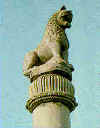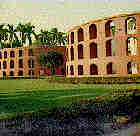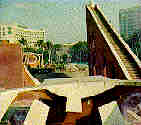Vedanta, Sankhya, Lokayata
Hindu Philosophical Schools
_____________________________________________________________
Table of Contents
_____________________________________________
 This site has been selected by Encyclopedia Britannica "as one of the best on the Internet, when reviewed for quality, accuracy of content, presentation and usability".
This site has been selected by Encyclopedia Britannica "as one of the best on the Internet, when reviewed for quality, accuracy of content, presentation and usability".
_________________________________________________
In the history of religious beliefs in ancient India, philosophical and speculative thought played a very important role. There existed various philosophical schools of which Vedanta, Sankhya and Lokayata could be considered as representative of the three major schools of thought.
Vedanta's Theism, Sankhya's Materialism and Lokayata's Rationalism
While the Vedanta school was theistic (believing in the existence of God),
the Lokayata school was materialistic and atheistic (believing in the existence of only those things whose existence could be seen, heard, felt, tasted and smelt). The Sankhya school was compromise between the
other two schools.
 | A part of the gold-plated Pagoda in Thailand. The Buddhist philosophy of Jivadya i.e. respect for all living forms has deeply influenced the outlook of the peoples of the Far-east. Buddhism with its emphasis on universal love and non-violence, has had a sobering influence on a significant part of the human species. |
While these philosophical schools played all important role in influencing the development of Indian religions, these philosophical schools themselves did not evolve into separate religions. They could not so evolve as they were intellectual traditions without any mass following. The lack of mass following had a positive effect as it kept the spirit of quest alive and disallowed the emergence of rigid commitment to certain ideas which prevented them from taking on the form of religion. Philosophical schools whether theistic or materialist remained distinct from religions proper. We shall explain in brief the nature of these different
philosophical traditions.
VEDANTA
Vedanta is the only philosophical tradition that remains alive today. The reason is that unlike any other philosophical school. Vedanta has been fully integrated into the Hindu religion. Vedanta
literally means 'end of the Vedas' but it is interpreted as 'culmination of the Vedas'. The founder of Vedanta tradition is said to be the Vedic Seer Vyasa, but its most well known exponent was Adi Shankaracharya. There were others too like Sayanacharya, Madhavacharya and many others.
The Vedanta system virtually represents Shankaracharya's interpretation of the Sutras. The Sutras are a collection of rituals and practices that have been sanctioned in Vedic literature.
The essence of Vedanta philosophy is that all human beings have souls (Atman). And although physically all beings have a separate existence, their souls are actually not separate. They are merged into one supreme soul (Param-Atmah) or the absolute soul (Brahman). This unity of different souls is called Advaita or non-dualism (also called Monism). The doctrine of Advaita is central to Vedanta philosophy. The visible and palpable universe around us is considered to be unreal (Mithya) which is but an illusion i.e. Maya), while that which is tbe supreme reality the absolute soul (Brahman) cannot be perceived by our normal senses of sight, smell, hearing or touch.
(The Vedanta philosophy continues to be very popular among Hindu philosophers and is a subject at many discourses at temples. There are many contemporary names associated with this philosophy. It is not possible to recollect all, but some of those who have based their principles on Vedanta Philosophy include A. Parthasarthy, Swami Chinmayananda, Maharshi Mahesh Yogi, among many others.)
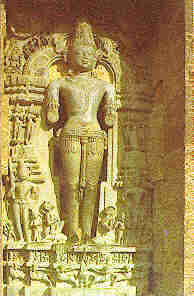 | Surya depicted at the Konark temple in Orissa as Vishnu - the Preserver. Vishnu is one of the three deities of the Hindu Trimurti (Triad or Trinity). The other two are Brahma - the Creator and Mahesh - the Destroyer. Thus there is a combination of three opposite tendencies of Creation, Preservation and Destruction in this concept. This was supposed to reflect the cosmic law of the working of the universe. |
SANKHYA
The Sankhya school is relatively materialistic as compared to Vedanta. The
founder of the Sankhya school is considered to be a philosopher named Kapila. The term Sankhya could be derived from Sankhyaa meaning 'numbers'. This could be so as Sankhya philosophy divides the universe into 25 principles (tattvas). The first 8 tattvas comprise of the material universe and are termed as Prakriti. One tattva (principle) is the motive power of the universe which is looked upon as the soul or spirit and is termed Purusha. The remaining 16 tattvas are the result of Purusha acting upon Prakriti and they
constitute the material universe with all its movements of rotation, revolution, gravitation.
Thus everything begins with matter (Prakriti) but this matter in itself is inert or dead, it is activated by the stimulus provided to
it by the motive power(Purusha) and the result of this is the active universe with its twinkling stars and rotating planets of which we are a part. The Sankhya system of ideas is thus not entirely theistic as it assumes the existence of both matter and motive power to begin with. The universe is not looked upon as the creation of a supreme creator. But the Sankhya doctrine is neither entirely materialistic. According to Sankhya, matter (Prakriti) which exists without any creator having created it, but is inert until it is activated by the motive power
(Purusha).
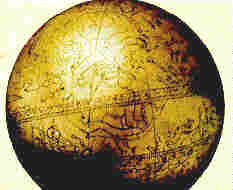 | Sankhya philosophy divides the universe into 25 principles (tattvas). The first 8 tattvas comprise of the material universe and are termed as Prakriti. One tattva (principle) is the motive power of the universe which is looked upon as the soul or spirit and is termed Purusha. The remaining 16 tattvas are the result of Purusha acting upon Prakriti and they
constitute the material universe with all its movements of rotation, revolution, gravitation. Seen here is an Astrolabe from the mediaeval India. An Astrolabe was used to measure the position of stars and planets for navigational purposes. |
Evidently the Sankhya doctrine tried to explain the existence (or creation) of the universe by extending the idea of sexual procreation to the entire universe. Incidentally, Purusha literally means "man" or male and Prakriti is one of the names of the Mother-Goddess.
Unlike Vedanta, the Sankhya doctrine was not incorporated into any religion. It never obtained wide acceptability among Hindu philosophers as did Vedanta. The most popular philosopher who is said to have propounded the Sankhya philosophy was Kapila. From the name it is uncertain whether this philosopher was a man or a woman. (Modern Indian philosophers like Rahul Sankrutyan and Devi Prasad Chattopadhyay have referred to the specualtions of Kapila.)
But Buddhism seems to have borrowed ideas from the Sankhya School. Thus this school appears to be of considerable antiquity and
must have existed since before the 6th century B.C.E. when Gautama
Buddha lived. But the Sankhya doctrine displays a dual character
which arises from the attempts made to reconcile materialistic logic
with the gaps in knowledge (perception)about the nature of the universe. In
this sense the Sankhya doctrine proves inadequate as an
intellectual doctrine as compared to another philosophical tradition or doctrine which was known as Lokayata (Derived from "Loka" meaning lay people) and which was thoroughly materialistic.
_______________________________________________________________________________________________________________________
(You have completed viewing half of this page. If you would like to have a sneak preview into the next page, before
you continue viewing the rest of this page, you may roll your mouse over the frame below to see the pictures on the next page
which talks about Sikhism.)
____________________________________________________________________________________________________________________
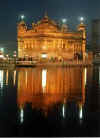
__________________________________________________________________________________________________________________________
_____
|
The script for the above applet has been written by Chintamani
Thakur.
LOKAYATA
The Lokayata doctrine tried to explain the nature of the
universe without the intervention of either God or devil.
 | "Truth" for Lokayata Philosophers was that which could be perceived by human senses of sight, hearing, smell, taste or touch. The Hathayoga discipline which lays emphasis of making the body the first object of duty (Shariram Aadyam Khalu Dharam-Saadhanam )has many parallels with the Lokayata outlook. |
"Truth" for the exponents of this tradition was that which could be
perceived by human senses of sight, hearing, smell, taste or touch.
This kind of a down-to-earth approach necessitated recognition of
the limits to human knowledge and capacity. But it also tethered
the exponents of Lokayata to a realistic and convincing approach.
Nothing was accepted as a matter of faith and the quest to know
more about the unknown was the driving force of this school.
According to the Lokayata doctrine, the universe was made up of
active physical forces (like gravitation) which activated and stimulated each other. But these physical forces although active were not alive as they did not move about consciously towards any set purpose. This is where the
Lokayata school differed from other philosophies which interpreted
the "active" quality of these forces as proof of their being "alive".
The idea that the active powers of the physical universe like
thunder, lightning, rain
and storms were alive and moved about consciously to achieve a set
purpose was the foundation of most philosophies.
The exponents of Lokayata did not believe in concepts such
as life after death or rebirth. A charge that was made against
adherents of this philosophy was that they emphasized only the
material aspects while disregarding spiritual ones. But this was
natural in a school which looked upon only the perceptible as
real.
Lokayata looked upon Man and his psyche a result of the
material conditions around him. In this respect this school came
close to modern interpretations which look upon man to be ultimately a result of physical evolution of the universe, and religion together with all aspects of the human psyche a result of Man's intellectual and emotional evolution.
Thus the Lokayata philosophy which seems closest to the modern Rationalism, seems to have been popular at some stage in history in ancient India. The term Lokayata itself can be translated as 'widespread among the people'. Its principle exponent is considered to be a
philosopher named Charavaka who is said to be a contemporary of Sri Krishna and if legend is to be believed, he was burned at the orders of Yudhisthira after the Mahabharat war. His crime was apostasy in declaring that the Vedas are not the ultimate in human knowledge.
Modern philosophers who have propounded this philosophy include like Dharmanand Kosambi, Rahul Sankrutyan and Devi Prasad Chattopadhyay.
There existed other philosophical schools like Nyaya,
Vaisheshika, Yoga and Mimansa, but the three schools discussed
here represented the major under-currents of Indian philosophical thought. As
mentioned earlier, philosophies interacted closely with religions and Hinduism, Buddhism, Jainism all show traces of ideas borrowed from the
different philosophical schools which strictly speaking were part of
no religion.
All the religions and philosophies
we have so far discussed originated in ancient times,
but among the religions that originated in India there is a
mediaeval one without the mention of which our discussion would be
incomplete. This religion is that of the Gurus of Punjab -
Sikhism.
_____________________________________________________________
________________________________
View the Table of Contents
_________________________________________________
_________________________________________________
We invite you to participate in an online chat in our Hindu History Chatroom.
___________________________________________________
_________________________
Other relevant sites
Hindu World
HinduNet
HinduWeb
Hindu Hriday Samrat
Hindu Books
Hindu Literature
HindutvaNet
Hindu Vivek Kendra
Hindu Students Council
RSS
VHP
________________________________________________
________________________________________________
